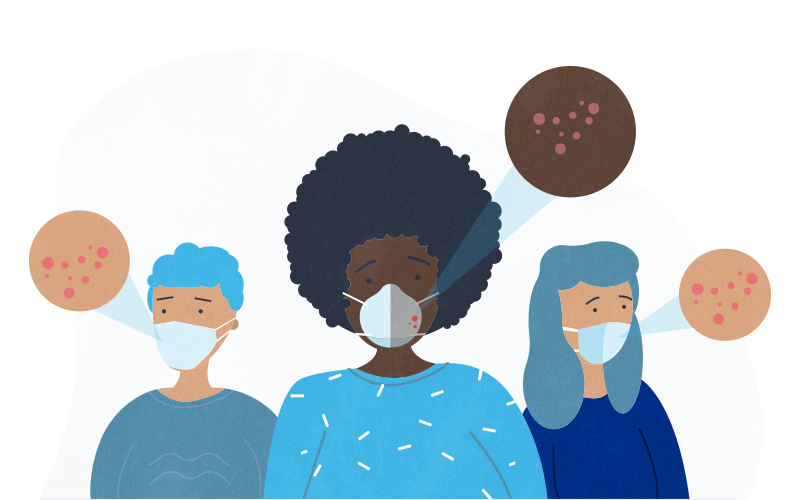Behind the mask: How to prevent and treat mask-related acne in children and teens

Wearing a mask is very effective at helping prevent the spread of COVID-19, but it can also trigger a host of skin problems for children and teens, including acne, irritation, rashes, and chafing behind the ears. Many adults are also suddenly experiencing acne and other skin issues for the first time in years. Fortunately, you and your family can take some key steps to prevent and treat these problems, making mask-wearing much more comfortable, says Dr. Sadaf Hussain, an attending dermatologist at Boston Children’s Hospital.
Steps for children and teens to prevent mask acne
Wearing a face mask can result in the skin’s pores becoming clogged, which can cause pimples to form. The warm environment of the mask also promotes the growth of bacteria on the skin, which can lead to an acne flare.
The best way to treat acne is to prevent it in the first place. Dr. Hussain offers the following mask-acne prevention tips for children and teens to follow. (Adults can try these, too, if needed.):
- Wash your face with a gentle, oil-free cleanser twice a day, rinsing thoroughly. You should also wash your face before you put your mask on and after you take it off, as well as after exercise.
- Apply a gentle moisturizing cream to your skin before putting on your mask to help reduce friction. Select a non-comedogenic cream that’s less likely to block pores. Wear sunscreen if you will be spending any time outdoors. (If you wear an N95 mask, talk to your doctor, since moisturizers can decrease the efficiency of the mask.)
- Make sure that your mask fits your face well and is comfortable. If it’s too loose, it is more likely to move around and cause chafing, which can lead to acne. It can also irritate the skin if it’s too tight.
- Select a mask made of a soft, breathable, natural fabric like cotton. (Synthetic fabrics like nylon, polyester, and rayon can be more irritating to your skin.) This is especially important if you are prone to acne or have oily skin. Disposable masks are also very breathable and can be a good option.
- Although the mask may look clean after one use, the fabric collects oil and dead skin cells. Wash your mask (or ask a parent to wash it) after each use, either hand washing it or running it through your washing machine. Use a fragrance-free, hypoallergenic detergent.
- While makeup becomes increasingly popular as teens get older, it’s important to avoid wearing it under the mask. The makeup can block pores and increase the risk of acne forming.
- If skin gets sweaty under a mask, take it off and wash your face.
- Everyone’s skin is likely to be more sensitive than usual due to the mask, so it’s a good idea to just stick to your normal routine and avoid experimenting with new facial products right now.
“Reusing a mask without washing it first is like wearing yesterday’s dirty underwear.”
— Dr. Hussain
Treating breakouts
If someone in your family is already experiencing mask-related acne or other skin problems, Dr. Hussain notes there are potential treatments such as benzoyl peroxide or topical retinoids that can address the problem, However, you’ll need to discuss the specific course of treatment with your pediatrician or dermatologist based on your child’s age.
Other advice to treat mask-acne in children and teens
- Switch to a cleanser made for sensitive skin if your child or teen has irritation. Make sure the cleanser you select contains no fragrance or plant or flower derivatives. With very sensitive skin, you may also want to avoid cocamidylpropyl betainel, an ingredient found in many soaps.
- To treat skin that is getting dried out from all of the washing and acne creams, be sure to moisturize twice a day.
- If mask loops are chafing the skin behind the ears, put petrolatum-based ointments on the sensitive area before wearing the mask. You can also use a mask extender, which is a strap that connects the mask ear loops behind your head and take the pressure off of your ear area.
If skin issues don’t get better, contact the Dermatology Program to make an appointment.
Related Posts :
-

How masks protect against COVID-19: Understanding the science
As the number of COVID-19 cases continue to rise in the U.S., including in children, wearing a face covering ...
-

How to encourage your child to wear a mask for COVID-19 protection
The U.S. Centers for Disease Control and Prevention recommends that everyone older than age 2 wear a face covering in ...
-

Model enables study of age-specific responses to COVID mRNA vaccines in a dish
mRNA vaccines clearly saved lives during the COVID-19 pandemic, but several studies suggest that older people had a somewhat reduced ...
-

New insight into the effects of PPIs in children
Proton-pump inhibitors (PPIs) are frequently prescribed to suppress stomach acid in patients with gastroesophageal reflux disease (GERD). Prescribing rates of ...





